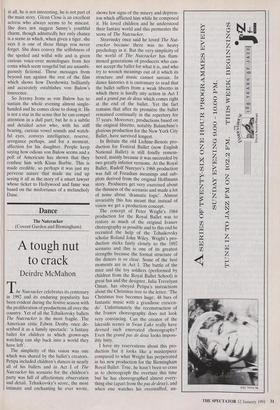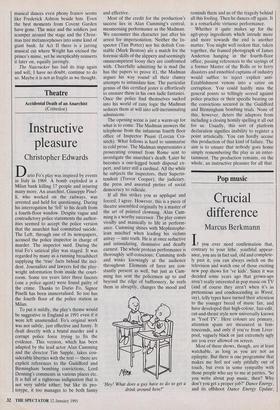Dance
The Nutcracker (Covent Garden and Birmingham)
A tough nut to crack
Deirdre McMahon
The Nutcracker celebrates its centenary In 1992 and its enduring popularity has been evident during the festive season with the proliferation of productions all over the country. Yet of all the Tchaikovsky ballets The Nutcracker is the most fragile. The American critic Edwin Denby once de- scribed it as a family spectacle: 'a fantasy ballet for children in which grown-ups watching can slip back into a world they have left'.
The simplicity of this vision was one which was shared by the ballet's creators. Petipa included children's dances in nearly all of his ballets and in Act I of The Nutcracker his scenario for the children's party was full of affectionate observation and detail. Tchaikovsky's score, the most intimate and enchanting he ever wrote, shows few signs of the misery and depress- ion which afflicted him while he composed it. He loved children and he understood their fantasy world and this permeates the score of The Nutcracker.
Stravinsky once said he loved The Nut- cracker because there was no heavy psychology in it. But the very simplicity of the world of The Nutcracker has flum- moxed generations of producers who can- not accept the ballet for what it is, and who try to wrench meanings out of it which its structure and music cannot sustain. In dance histories it is customary to read that the ballet suffers from a weak libretto in which there is hardly any action in Act I and a grand pas de deux which comes right at the end of the ballet. Yet the fact remains that after its premiere the ballet remained continually in the repertory for 37 years. Moreover, productions based on the original libretto, notably Balanchine's glorious production for the New York City Ballet, have survived longest. In Britain the old Lichine-Benciis pro- duction for Festival Ballet (now English National Ballet) is still fondly remem- bered, mainly because it was succeeded by two greatly inferior versions. At the Royal Ballet, Rudolf Nureyev's 1968 production was full of Freudian meanings and sub- plots derived from the original Hoffmann story. Producers get very exercised about the thinness of the scenario and made a lot of noise about 'dramatic logic'. Almost invariably this has meant that instead of vision we get a production concept. The concept of Peter Wright's 1984 production for the Royal Ballet was to restore as much of the original Ivanov choreography as possible and to this end he recruited the help of the Tchaikovsky scholar Roland John Wiley. Wright's pro- duction sticks fairly closely to the 1892 scenario and this is one of its greatest strengths because the formal structure of the dances is so clear. Some of the best moments are in Act I. The battle of the mice and the toy soldiers (performed by children from the Royal Ballet School) is great fun and the designer, Julia Trevelyan Oman, has obeyed Petipa's instructions about the Christmas tree to the letter: 'The Christmas tree becomes huge; 48 bars of fantastic music with a grandiose crescen- do'. Unfortunately the reconstruction of the Ivanov choreography does not look very convincing. Can the creator of the lakeside scenes in Swan Lake really have devised such enervated choreography? Even the grand pas de deux looks imposs- ibly bitty. I have my reservations about this pro- duction but it looks like a masterpiece compared to what Wright has perpetrated in his new production for the Birmingham Royal Ballet. True, he hasn't been so crass as to choreograph the overture this time but he has choreographed almost every- thing else (apart from the pas de deux), and when one watches his overstuffed, un- musical dances even phony Nano)/ seems like Frederick Ashton beside him. Even the best moments from Covent Garden have gone. The mice and the soldiers just scamper around the stage and the Christ- mas tree metamorphoses into some kind of giant bush. In Act II there is a jarring musical cut where Wright has excised the prince's mime, yet he inexplicably reinserts it later on, equally jarringly.
The Nutcracker has laid its trap again and will, I have no doubt, continue to do so. Maybe it is not as fragile as we thought.











































 Previous page
Previous page